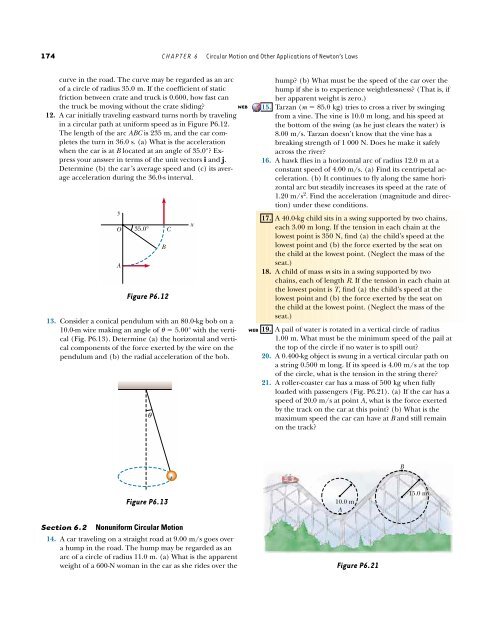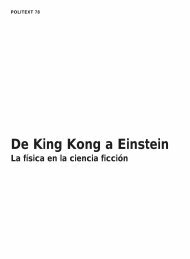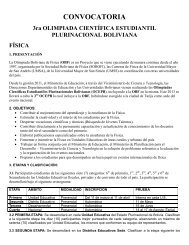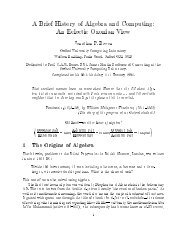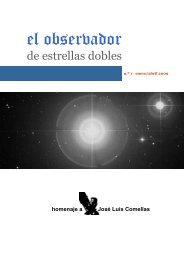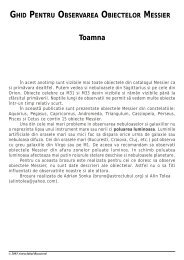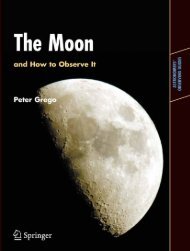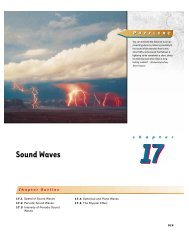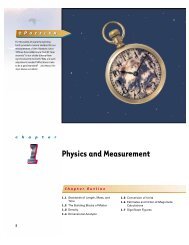Circular Motion and Other Applications of Newton's Laws
Circular Motion and Other Applications of Newton's Laws
Circular Motion and Other Applications of Newton's Laws
Create successful ePaper yourself
Turn your PDF publications into a flip-book with our unique Google optimized e-Paper software.
174 CHAPTER 6 <strong>Circular</strong> <strong>Motion</strong> <strong>and</strong> <strong>Other</strong> <strong>Applications</strong> <strong>of</strong> Newton’s <strong>Laws</strong><br />
curve in the road. The curve may be regarded as an arc<br />
<strong>of</strong> a circle <strong>of</strong> radius 35.0 m. If the coefficient <strong>of</strong> static<br />
friction between crate <strong>and</strong> truck is 0.600, how fast can<br />
the truck be moving without the crate sliding?<br />
12. A car initially traveling eastward turns north by traveling<br />
in a circular path at uniform speed as in Figure P6.12.<br />
The length <strong>of</strong> the arc ABC is 235 m, <strong>and</strong> the car completes<br />
the turn in 36.0 s. (a) What is the acceleration<br />
when the car is at B located at an angle <strong>of</strong> 35.0°? Express<br />
your answer in terms <strong>of</strong> the unit vectors i <strong>and</strong> j.<br />
Determine (b) the car’s average speed <strong>and</strong> (c) its average<br />
acceleration during the 36.0-s interval.<br />
y<br />
O<br />
A<br />
35.0°<br />
13. Consider a conical pendulum with an 80.0-kg bob on a<br />
10.0-m wire making an angle <strong>of</strong> � � 5.00° with the vertical<br />
(Fig. P6.13). Determine (a) the horizontal <strong>and</strong> vertical<br />
components <strong>of</strong> the force exerted by the wire on the<br />
pendulum <strong>and</strong> (b) the radial acceleration <strong>of</strong> the bob.<br />
Section 6.2 Nonuniform <strong>Circular</strong> <strong>Motion</strong><br />
14. A car traveling on a straight road at 9.00 m/s goes over<br />
a hump in the road. The hump may be regarded as an<br />
arc <strong>of</strong> a circle <strong>of</strong> radius 11.0 m. (a) What is the apparent<br />
weight <strong>of</strong> a 600-N woman in the car as she rides over the<br />
B<br />
C<br />
Figure P6.12<br />
θ<br />
Figure P6.13<br />
x<br />
WEB<br />
WEB<br />
hump? (b) What must be the speed <strong>of</strong> the car over the<br />
hump if she is to experience weightlessness? (That is, if<br />
her apparent weight is zero.)<br />
15. Tarzan (m � 85.0 kg) tries to cross a river by swinging<br />
from a vine. The vine is 10.0 m long, <strong>and</strong> his speed at<br />
the bottom <strong>of</strong> the swing (as he just clears the water) is<br />
8.00 m/s. Tarzan doesn’t know that the vine has a<br />
breaking strength <strong>of</strong> 1 000 N. Does he make it safely<br />
across the river?<br />
16. A hawk flies in a horizontal arc <strong>of</strong> radius 12.0 m at a<br />
constant speed <strong>of</strong> 4.00 m/s. (a) Find its centripetal acceleration.<br />
(b) It continues to fly along the same horizontal<br />
arc but steadily increases its speed at the rate <strong>of</strong><br />
1.20 m/s2 . Find the acceleration (magnitude <strong>and</strong> direction)<br />
under these conditions.<br />
17. A 40.0-kg child sits in a swing supported by two chains,<br />
each 3.00 m long. If the tension in each chain at the<br />
lowest point is 350 N, find (a) the child’s speed at the<br />
lowest point <strong>and</strong> (b) the force exerted by the seat on<br />
the child at the lowest point. (Neglect the mass <strong>of</strong> the<br />
seat.)<br />
18. A child <strong>of</strong> mass m sits in a swing supported by two<br />
chains, each <strong>of</strong> length R. If the tension in each chain at<br />
the lowest point is T, find (a) the child’s speed at the<br />
lowest point <strong>and</strong> (b) the force exerted by the seat on<br />
the child at the lowest point. (Neglect the mass <strong>of</strong> the<br />
seat.)<br />
19. A pail <strong>of</strong> water is rotated in a vertical circle <strong>of</strong> radius<br />
1.00 m. What must be the minimum speed <strong>of</strong> the pail at<br />
the top <strong>of</strong> the circle if no water is to spill out?<br />
20. A 0.400-kg object is swung in a vertical circular path on<br />
a string 0.500 m long. If its speed is 4.00 m/s at the top<br />
<strong>of</strong> the circle, what is the tension in the string there?<br />
21. A roller-coaster car has a mass <strong>of</strong> 500 kg when fully<br />
loaded with passengers (Fig. P6.21). (a) If the car has a<br />
speed <strong>of</strong> 20.0 m/s at point A, what is the force exerted<br />
by the track on the car at this point? (b) What is the<br />
maximum speed the car can have at B <strong>and</strong> still remain<br />
on the track?<br />
10.0 m<br />
A<br />
Figure P6.21<br />
B<br />
15.0 m


